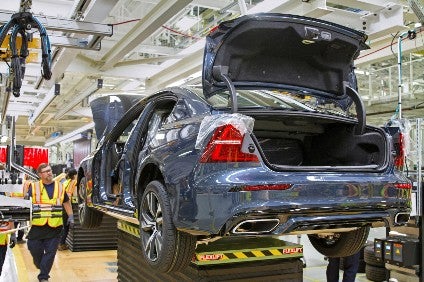
Hefty incentives and an extra selling weekend in June pushed US light vehicles sales into the black for the first half of 2018.
Even interest rates at nearly nine year highs didn’t stop buyers from closing deals on 1.55m cars and light trucks, 5.2% ahead last June’s tally.

Discover B2B Marketing That Performs
Combine business intelligence and editorial excellence to reach engaged professionals across 36 leading media platforms.
June’s seasonally adjusted annualised rate (SAAR) came in at 17.47m, well ahead of both June 2017 and May 2018.
Over the six months from January to the end of June, total light vehicle sales rose 1.9% to more than 8.6m. In fact, total H1 volume was within 4,000 units of matching 2016, a record sales year.
Almost every car maker posted year-over-year (YOY) gains with American Honda, Nissan North America and Subaru setting records. Audi squeaked by to add a 104th month to its industry-leading streak.
Jeep delivered its best-ever June sales and padded its lead in the all-important utility segment while leading FCA to the largest improvement of the Detroit Three. Both Fiat Chrysler and General Motors, which reported second-quarter and first-half sales, are solidly in the black while Ford, which posted the smallest increase of the group, is still in the red.
Riding on the coat tails of the Outlander, Mitsubishi came through with the largest monthly YOY improvement while Volvo delivered the most growth in H1 deliveries. Hyundai, Mazda and Subaru all were up by double digits.
Rising petrol prices haven’t yet dampened Americans’ appetite for crossovers, SUVs and pickup trucks. They accounted for 62.9% of total June turnover with more than twice the volume of passenger cars. Autos claimed just 31.2% of June deliveries and they made up just 32% of H1 volume.
It’s not just the US brands: the Tiguan and Atlas claimed 45% of Volkswagen’s total last month and Honda’s June record was built on light truck sales.
While the first half was welcome news to automakers, the next six months would challenge the divining skills of the best odds makers.
There’s little doubt that June’s performance was bought and paid for. Analysts estimated GM spent an average of US$5,000 (GBP3,778) to move each vehicle. It’s going to be a challenge to continue this pace without putting a serious hurt on earnings.
Interest rates will continue to grow; the Federal Reserve Board is planning at least one more increase this year. This means financing will become more costly, either for consumers or for automakers’ subvented loan costs. This means it’s critical to keep buyer focus on the more profitable light trucks. This could be risky if petrol prices rise above $3.50/gallon (GBP0.70 per litre) and it’s currently at $2.87 (GBP0.57 litre) a 29% increase from a year ago.
Then there’s the question of tariffs. Nearly a quarter of the vehicles sold in the US so far this year have been imports – vehicles made outside of the US, Canada and Mexico. Add
those produced in our current NAFTA partner countries, Canada and Mexico, and it takes the non-US share to a whole new level. The trade war, started by a certain US politician as a way to promote jobs creation in the US, could easy gut light vehicle sales as the cost of vehicles and the materials used to make them skyrocket.
It’s likely that most Americans don’t really understand the true costs of a trade war. Very few outside of the industry know that they are still paying a high tariff on commercial vehicles that dates back 54 years. Elimination of that tariff could substantially reduce the cost of some light commercial vehicles by eliminating the costs of circumventing it.
Conversely, expanding the tariffs could greatly increase the cost of a new vehicle, which along with rising interest rates, could cause a meltdown in US sales.
So the headwinds the industry is facing could rise to gale force in the near future. It’s probably wise for carmakers to take a moment and celebrate the gains they made in the first half of 2018.
* indicates a sales record.
Note: Monthly sales figures for General Motors are estimates.
**Volkswagen Group figures include Audi, Bentley, Porsche and Volkswagen brands
Other includes estimated sales for Aston-Martin, Ferrari, Lamborghini, Lotus, McLaren, Rolls-Royce and Tesla






